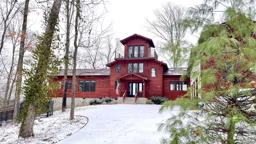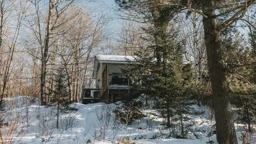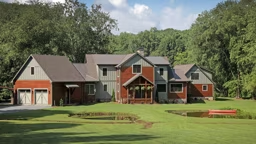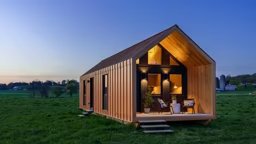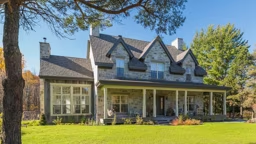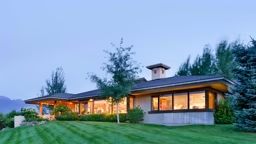Photos: Courtesy of Wheelhaus
There’s a lot of buzz these days about something called
The Tiny House Movement, a back-to-basics concept that promotes simple living in super-small homes. The idea—fueled by dreams of financial freedom, a simpler lifestyle and the goal of leaving a lighter footprint on the planet—has even spawned a crop of new TV shows starring the minute dwellings.
While the premise behind the trend is simple, today’s tiny homes are anything but. One example is the Caboose, a sophisticated modular cabin created by
Wheelhaus, a company based in Wyoming. Filled with high-end materials and custom woodwork, this “recreational park trailer” feels much more like a luxury house than a
pre-fab rolling cabin that can be transported just about anywhere.
“It’s the BMW of the tiny house movement,” says Wheelhaus owner Jamie Mackay. “Its architecture, full timber-frame roof system and top-of-the-line fixtures and materials set it apart from other homes in this market.”
Downsizing
While portable homes are often designed with mobility in mind, the Caboose cabin is intended to serve as a more permanent residence. Though its main area measures just 400 square feet, the luxury mobile cabin is making a mark as a full-time residence for many homeowners.
“People are starting to realize they don’t need as much as they thought they needed to live,” Mackay explains. “People often have an albatross of things around their neck, and we are showing them how they can be liberated from the story of stuff. Think about everything in your closet that you haven’t worn in 12 months—you really don’t need it all.”
“The recession really took a toll on people, and it made them realize that they don’t need the extra cost or the burden of a huge home with a big lawn to mow,” Mackay says. “A lot of the spaces in today’s homes, such as dining rooms, are vacant, unnecessary rooms that cost money to heat.”
Thoughtful Design
When Mackay set out to create the floor plan for the Caboose, he spent time thinking about where people spend most of their time.
“We all gravitate to the kitchen and living room, so these are the areas we focused on,” he says.
The layout incorporates an open
kitchen/living room area with vaulted ceiling, one bedroom, one bathroom, a private deck and a bonus 120-square-foot loft area that measures 5 feet high. The front of the model is almost entirely glass.
“The cabin has a big glass factor,” Mackay says. “This helps bring the outside in, so the space doesn’t feel so confined.”
The hallmark of the cabin’s design is its striking architecture. “It resembles an old railroad car, and its full timber-frame roof system enhances its architectural appeal,” Mackay explains. “It’s a true, structural roof system complete with wooden pegs, and the cabin has a standing seam metal roof that can accommodate solar.”
Green, Not Lean
The potential for solar isn’t the only eco-friendly aspect of the design. Reclaimed wood, SIPs, Energy Star appliances, and windows and doors with high R-values have all helped Wheelhaus meet LEED Gold Standards and achieve a Certified Green designation.
“We place a high value on building with sustainability,” he says. Luxury plays an equally important role in the Caboose. Granite countertops, stainless-steel appliances, custom cabinetry, hardwood floors, Travertine tile, quartzite and a gas-burning fireplace all sound a note of sophistication in the trailer home (which feels much more like a house than an RV).
Outside, cedar siding, reclaimed wood and metal tiles with an aged patina impart a look of distinction. The cabin comes complete with all hardware, appliances and finishes. “We’re building a very high-end home,” Mackay says. “We want to do the best we can with the space we have, so we’re always evolving—for example, we made the ceiling heights higher and the hallway wider so that it doesn’t feel so tiny.”
One Size Fits All
Those who buy the Caboose (which measures just 10.5 feet by 38 feet )are drawn to its distinctive roofline and contemporary lines, as well as the extra space that the loft provides.
Some owners opt to use the loft as their main sleeping area, converting the downstairs bedroom into an office area instead. Others use the loft as sleeping quarters for grandkids. Another bonus feature of the Caboose is its spacious outdoor deck, which expands the living space of the small cabin and affords spectacular views of the surrounding landscape.
The model shown on these pages is set on the grounds of the Fireside Resort in Jackson Hole, Wyoming, which offers breathtaking vistas of the Teton Range, picturesque woodland and the Snake River.
“When visitors enter, they are stunned by how spacious the cabin feels,” Mackay says. “They all say it feels bigger than it really is, and that the photos don’t do it justice.”
If you’d like to find out just how big a tiny cabin can feel, try it out for yourself—for your next vacation, you can rent this cabin or another Wheelhaus cabin on the grounds of Fireside Resort. But be warned—if you fall in love with one of the cabins, you just might find yourself rolling home a keepsake that costs a bit more than a typical souvenir shotglass.
See also: You Won't Believe This Prefabricated Home






